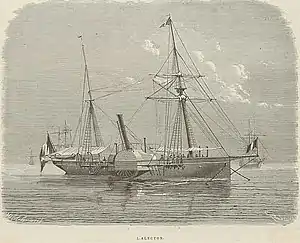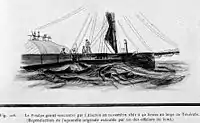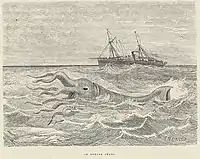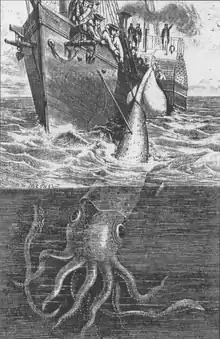French corvette Alecton
The French corvette Alecton was a ship in the French Navy in the 19th century. She is most famous for having been one of the first surface vessels recorded to have encountered a giant squid (Architeuthis). Until this time, giant squid were viewed as mythical creatures.
 The French aviso Alecton, launched 1861. | |
| History | |
|---|---|
| Name | Alecton |
| Laid down | 1859 |
| Launched | 1861 |
| Fate | Decommissioned 10 August 1883 and scrapped in 1884 at Lorient |
| General characteristics | |
| Class and type | Alecton class |
| Displacement | 570 tonnes |
| Length | 50.9 m |
| Beam | 12.1 m |
| Draught | 2.7 m |
| Propulsion | 120 hp steam engine and sails on two masts |
| Complement | 66 |
| Armament | two light cannon |
Service history
The Alecton, named after Alecto, one of the three Furies, was a paddle wheeler (aviso à roues de deuxième classe, type Étoile modifié) laid down in 1859 at the La Seyne shipyard of the Société des Forges et Chantiers de la Mediterranée and launched in 1861.[3][4] She had a length of 50.9 metres and a beam of 12.1 metres. Alecton was powered by both a 120 hp steam engine and sails on two masts, had a crew of sixty-six and an armament of two light cannons. Her displacement was 570 tonnes. Alecton was first stationed at French Guiana and from 1868 onwards at Guadeloupe. She was decommissioned on 10 August 1883 and scrapped in 1884 at Lorient.[4][3]
Bouyer's travelogue
Frédéric Bouyer who served as captain on the Alecton wrote a travelogue, which first appeared as an article in Le Tour du Monde in 1866,[1] later published as a book, La Guyane française: notes et souvenirs d'un voyage exécuté en 1862-1863 (1867).[5]
These carried illustrations done by artists based on sketches made by officers on the Alecton[6] and Bouyer himself.[7] The illustration of the ship was by Édouard Riou, based on the sketch by E. Rodolphe, the ship-of-the-line ensign (enseigne de vaisseau)[lower-alpha 1] aboard Alecton.[1][9]
The encounter with the gigantic squid occurred in 1861 when the boat was under his command.[10]
Giant squid encounter
near Tenerife, November 1861




(Reused by): Lee, Henry, 1884[14]
On November 30, or November 17,[4] 1861 the French corvette Alecton was, on its way to Cayenne, navigating near Tenerife, the largest and most populous island of the seven Canary Islands. As the ship neared the island the lookout on duty yelled to the crew below: “a large body, partly submerged, on the surface”.[15] The captain, Frédéric Bouyer, himself would later describe the monster as a "gigantic squid" (French: encornet gigantesque).[16]
The captain had heard reports of giant squid but the scientific community disputed their existence. Mutilated, decomposed pieces of giant squid had surfaced, most notably off Zealand, Denmark in 1847, and another at The Skaw in 1854. Yet no one had ever captured or even seen a live specimen.[15] Resolved to capture the monster, the captain ordered the ship to fire muskets, launch harpoons, and try to ensnare the squid with a noose.[17]
The bullets seemed to do little damage to the squid's rubbery body,[19] estimated at up to 18 feet (5.5 m) in length from "head to tail" (excluding the length of arms).[20][21][4] Finally they managed to lasso a rope around its body. However, the weight was so great that when they tried to haul it aboard, the squid's body was torn and only the tip of the tail remained aboard, which weighed 14 kg according to the captain.[22][18]
The fragmentary sample was definitely sent to a museum for study, but whether it still remained preserved could not be established by scholars by the following year, in 1862.[23]
Twenty Thousand Leagues Under the Sea
The Alecton encounter of 1861 was the inspiration for the giant squids attacking the submarine in Twenty Thousand Leagues Under the Sea, a classic science fiction novel by French writer Jules Verne, published in 1870.[24][25] Verne ascribed vicious behavior to the giant squid to paint it as a monster of legend, and the physical descriptions did not square with the living creature.[25]
Explanatory notes
- The enseigne de vaisseau was first officer.
References
- Citations
- Bouyer (1866), p. 273.
- Bouyer (1867), p. 3.
- Roberts, Stephen S (2021). "Chapter 4. Avisos, Special Ships, and Gunboats 1859–1882". French Warships in the Age of Steam 1859–1914. Barnsley, UK: Seaforth Publishing. ISBN 9781526745347.
- Clouet, Alain (2005–2011). "Avisos à roues de 2e classe" [2nd class paddle avisos]. la Flotte de Napoléon III. 1850 - 1870. Archived from the original on 2015-10-29. Retrieved 2015-08-03.
- Bouyer (1867).
- Bouyer (1867), title page
- Bouyer (1867), p. 223.
- Frédol, Alfred (ps. de Alfred Moquin-Tandon) (1865), Le monde de la mer, Hachette, p. 314a; alt copy via biodiversity library
- "E. Rodolphe" according to Frédol aka Moquin-Tandon.[8]
- Bouyer (1867), pp. 20–21.
- Bouyer (1866), p. 276.
- Bouyer (1867), p. 20.
- Figuier, Louis [in French] (1866). La vie et les moeurs des animaux zoophytes et mollusques par Louis Figuier. Paris: L. Hachette et C.ie. p. 467.. Eng. tr. (1868) The Ocean World, p. 457
- Lee (1884), p. 365.
- Ley, W. (June 1941), "Scylla Was a Squid", Natural History Magazine, 48 (1), retrieved 2022-02-03
- Bouyer (1867), p. 21.
- Bouyer (1867), p. 20: "pris la résolution de m'emparer du monstre.. on charge le fusils, ou emmanche les harpons, on dispose les nœuds coulant.."
- Lee (1884), p. 40.
- Capt. Bouyer himself says muskets (fusils) and "bullets" according to Henry Lee in 1884[18] is consistent as opposed to "cannon" written by Willy Ley in 1941.[15]
- Bouyer (1867), p. 21: "dix-huit pieds de à la tête a la queue".
- Lee (1884), p. 40: "estimated to have been from 16 feet to 18 feet.. without reckoning [the] arms".
- Bouyer (1867), p. 21: "..déchira et nous n'amenâmes à bord qu'un tronçon de la queue".
- Crosse, [Henri]; Fischer, [Paul] [in French] (1862), "Nouveaux documents sur les Céphalopodes gigantesques", Journal de Conchyliologie, 3e serie, 10 (in French): 135, n(1),
Les fragments de ce Céphalopode existent ou existaient au muséum; "Quelques-uns des viscères du nôtre sont déposés la galerie d'anatomie coparée du museum." (Quoy et Gaimard, l. c.) [Zool. de l'Uranie, t. I, 2e partie, p. 411]
alt copy via Gallica - Hatcher & Battey 2011, p. 44
- Fisher, Arthur (May 1995). "He Seeks the Giant Squid". Popular Science ((Special issue: Oceans at Risk/Ocean Planet)): 30. via Ocean Planet, accessed 2015-07-12.
- Bibliography
- Bouyer, Frédéric [in French] (January 1866), Charton, Édouard (ed.), Riou, Édouard (illustr.); "nos plus célebrès artistes [d'Hachette]" (illustr.), "Voyage dans la Guyane Française", Le Tour de Monde: Nouveau journal des voyage, Paris: L. Hachette et cie (!3): 273–304 alt copy via BnF
- Bouyer, Frédéric [in French] (1867), La Guyane française: notes et souvenirs d'un voyage exécuté en 1862-1863, Riou, Édouard (illustr.); Rapine; Delahaye (old natural history illustr.); Touboulic; Masson; Farcy; Rodolphe, officiers de la marine impériale (original sketches), Paris: L. Hachette et cie, pp. 39–40; alt copy via BnF
- Hatcher, Paul; Battey, Nick (2011). Biological Diversity: Exploiters and Exploited. John Wiley & Sons. ISBN 9780470979860. —440 pp.
- Lee, Henry (1884), "The Kraken", Sea Monsters Unmasked, The Fisheries Exhibition Literature 3, Chapman and Hall, pp. 39–40
External links
 Media related to Alecton encounter at Wikimedia Commons
Media related to Alecton encounter at Wikimedia Commons